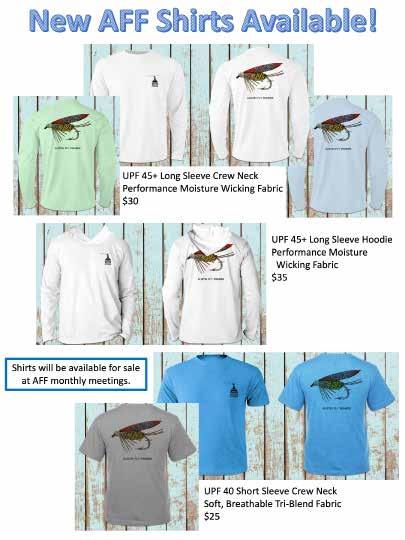
July - September 2024
Volume 26 Issue 3

President Vice
Manuel
Treasurer
Jim
Secretary
Kathi
Past
Dave
Conservation
Keith
Education
Austin
Merchandise
Shawn
Membership Gary
Nils

Webmaster Brandon
Julian
To



July - September 2024
Volume 26 Issue 3

President Vice
Manuel
Treasurer
Jim
Secretary
Kathi
Past
Dave
Conservation
Keith
Education
Austin
Merchandise
Shawn
Membership Gary
Nils

Webmaster Brandon
Julian
To

by Rasmus Ovesen
Photos by Rasmus Ovesen, Martin Ejler Olsen and Keith Rose-Innes
The Seychelles is an archipelago located North of Madagascar and it mainly consists of small coral islands, atolls and reefs. The Seychelles is home to some of the best and most diverse tropical saltwater fly fishing in the world. However, even the most competent fly fishermen may find that some of the challenges encountered when targeting fish in this rich aquatic ecosystem can lead to disappointment and even despair.
I’m bewildered and overwhelmed. Beat up and dizzy like a humiliated and defeated boxer who has just left the ring. I visualize the scenes from a full week of exciting tropical flats fishing that flicker before my feverish eyes as I gaze across the shimmering turquoise blue water.
I’m in the middle of the Indian Ocean aboard a catamaran heading for Alphonse Island -a haven that provides a luxurious basecamp for exploring nearby St. Francois Atoll. This near pristine atoll has shiny white flats, moonscape-like coral formations and riveting tidal currents. All of these features in combination with vast elongated subaqueous meadows of turtle grass, and weather-beaten outer reefs constitute the heart and soul of St. Francois’ world famous fishing grounds. The atoll unobtrusively fades away behind us like a bittersweet diminuendo that quietly yields to total silence. All of this stings relentlessly inside the depths of my soul as I cast one last glance behind me and take in the scenery for the last time. I suddenly realize that I’ve never been so sad having to pack up and leave a fishing destination as I am now. It’s a veritable tragedy!
“Only what is lost is eternally owned” sounds like a trite old proverb, which unfortunately makes good sense now that everything is over. In this very moment I feel as if I have been in a bizarre Film Noir-like drama. An anti-climactic drama, hopeless and dark, where I have had close encounters with the full cast of St. Francois Atoll villains: bonefish, triggerfish, milkfish, permit and giant trevally. Where in a morass of nerves, failed technique, and unfortunate circumstances I’ve lost everything!


Everything gets off to a good start. My faithful fishing buddy, Martin Ejler Olsen, and I begin building our confidence by catching a handful of bonefish on the flickering white sand flats of the St. Francois Atoll. Bonefish in combative sizes that seem completely magnetized by our flies, constantly impressing us with their shimmering pearlescent glow, silvery flanks, iridescent blue fin strokes, and phantom-like runs, which make our fly reels hiss. Additionally, we caught a yellow-lip emperor, a couple of groupers and a lemon shark of about 90lbs. And I get to cast to a giant trevally along the so-called Lollipop Reef. This fish turns after the fly with inexorable resoluteness, heading straight towards me. It inhales the fly at such a pace, that I don’t stand a chance of hooking it. The line goes slack and the fly is spat out before I ever get to establish contact.
Encouraged by yesterday’s great fishing, we now spend our second day buoyantly scouting and blind-casting along tidal currents, depth curves and reefs in the hopes of hooking one of the atoll’s terrifying giant trevallies. This powerful and lightning-quick predator species, because of its keen eyesight, bloated ego, menacing mannerisms and inflammable temperament has risen to near-mythical status among saltwater fly fishermen and come to be known as the ‘gangster of the flats’. Unfortunately, on this particular day they are like flickering, ominous ghosts. They disappear just as abruptly as they emerge and when we finally manage to get a couple of quality casts in, they display an atypical apathetic indifference to our flies.
After a whole day with nothing but a few side-catches in the shape of garfish, grouper and bluefin trevally, we revise our plans for the following day. Here, we fish along the western reaches of the St. Francois Atoll
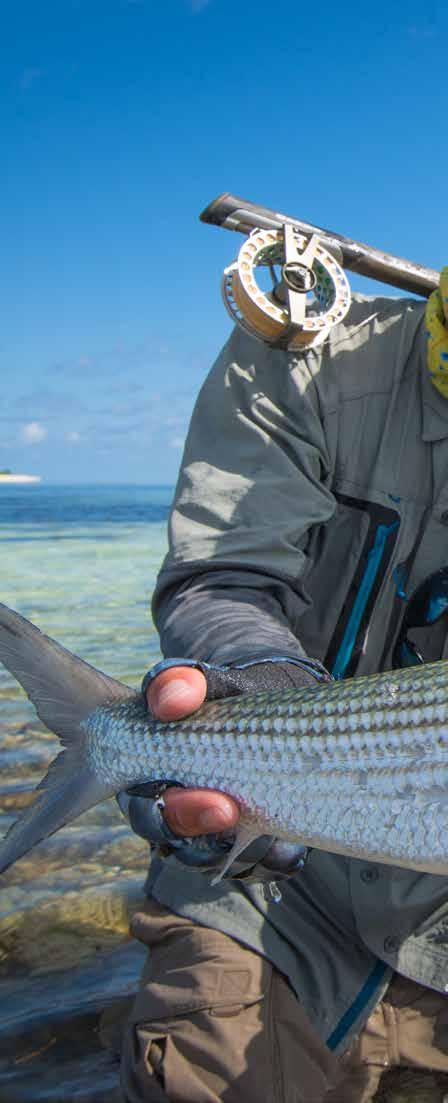

where an elongated moonscape-like coral reef constitutes a staunch but scarred barrier against the agitated sea.
The tide is high and our plan is to sight-fish for some of the atoll’s numerous triggerfish. They are a rather goofy looking and incredibly aggressive fish that is equipped with toothy jaws designed for breaking down corals and crushing crustaceans and mussels. The fact that it is capable of chewing flies (and fingers) clean through only serves as further testament to its reputation as one of the most exciting game fish in the Indo-Pacific Ocean.
The combat fishing that ensues surpasses all of our expectations. With great assistance from our guide, Brandon, who jumps headlong on the fish with his landing net as soon as they’re hooked, we manage to land three out of the five uptight triggerfish that gulp down our crab flies. In addition to triggerfish, we also catch three yellow-lip emperors, a few groupers, several unidentifiable coral fish, and a couple of solid bonefish. With both triggerfish and bonefish on my scorecard today, Brandon suggests that we end with half-an-hour’s worth of blind-casting with poppers for giant trevally. If all ends well, I could end up with an Indo-Pacific grand slam.
Along a sandy flats bar with a relatively drastic drop off, we’re now busy casting and retrieving our noisy NYAP poppers in the hopes of a redeeming strike. There’s plenty of small mullet and other baitfish around, so things look promising. It isn’t me, however, who suddenly experiences the violent burst and tug from a giant trevally. Ten minutes before our guided day session is over, Martin’s popper is brutally torn off the surface and he feels the tug from a tenacious fish. He
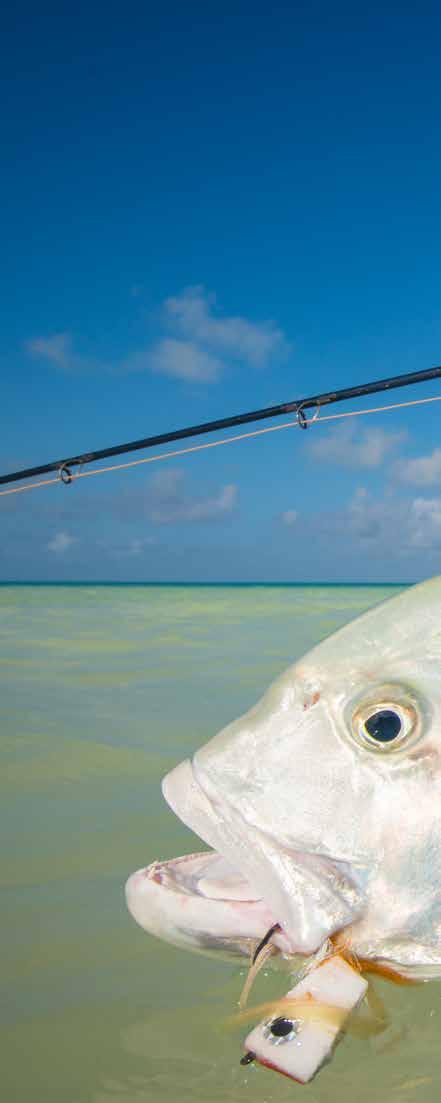
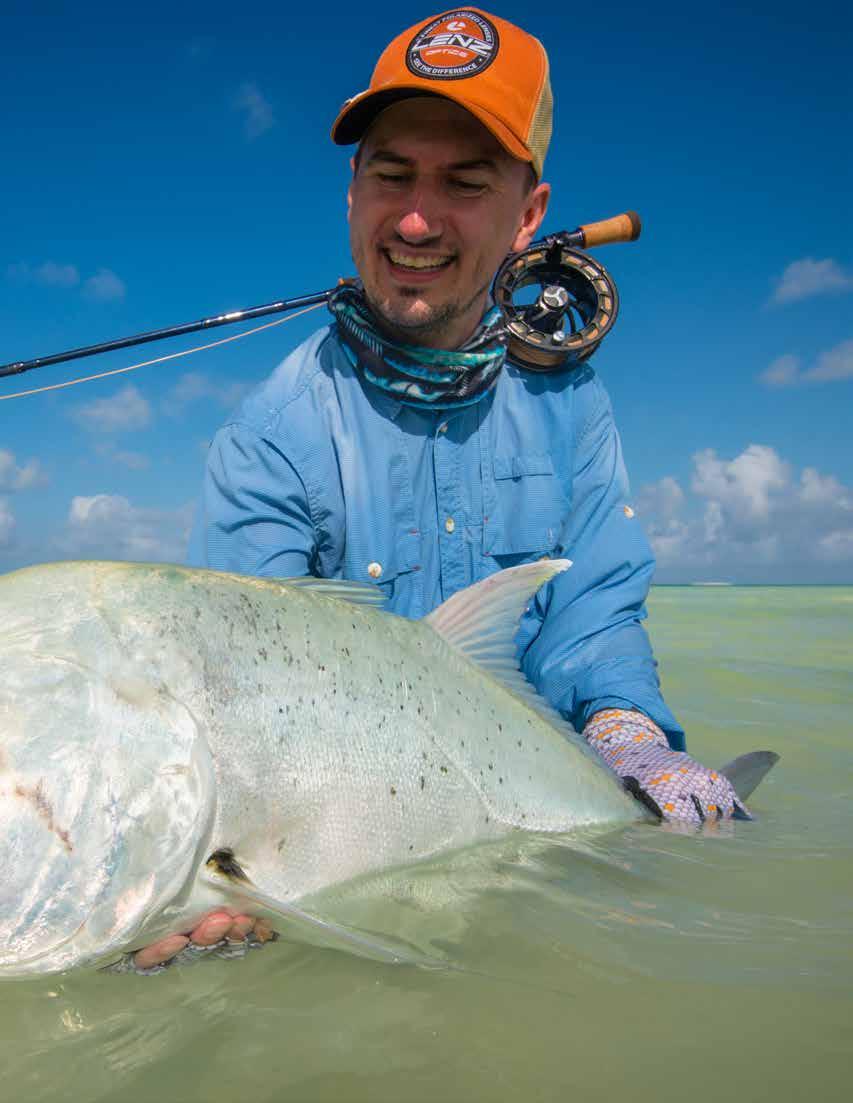
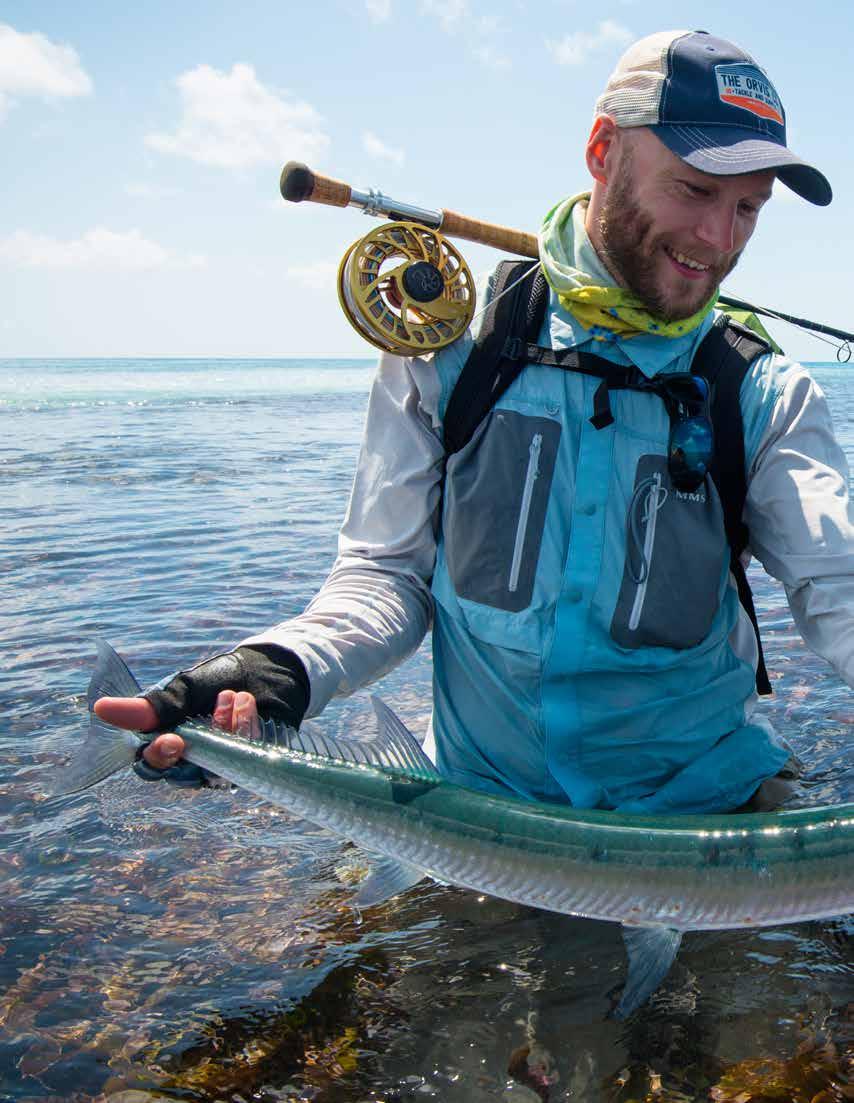
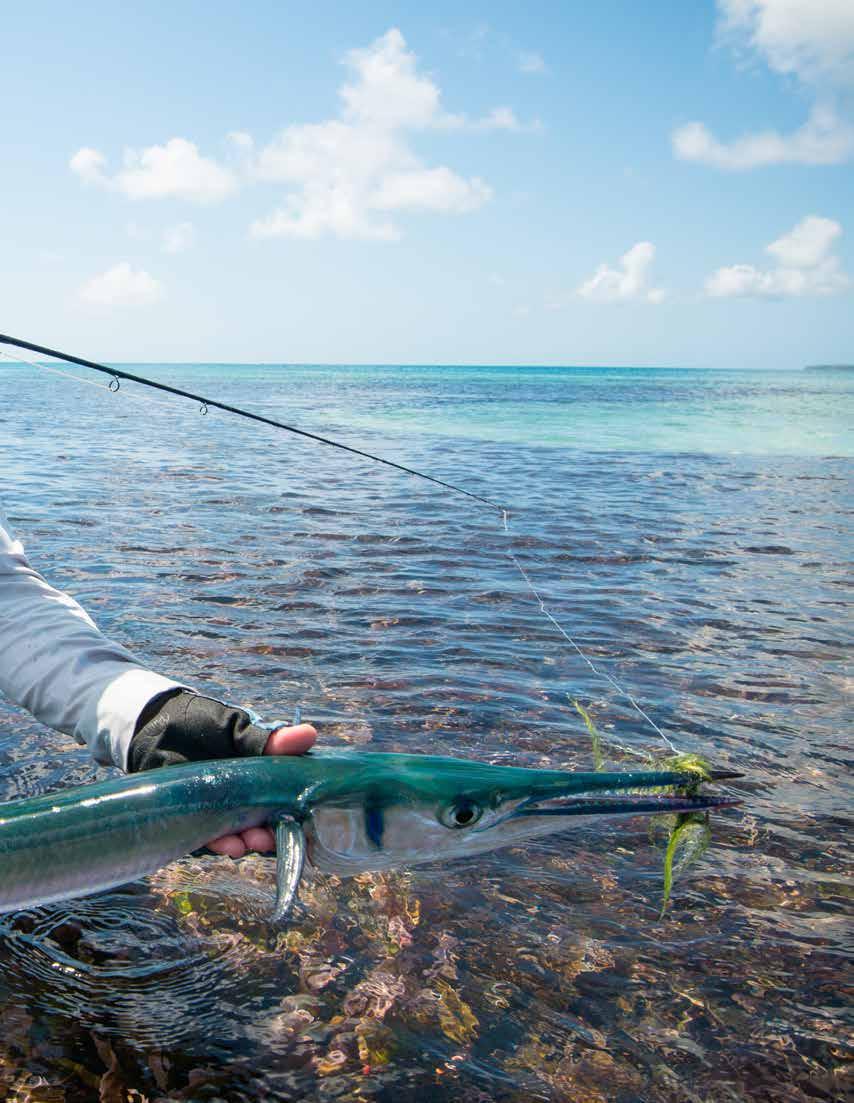
handles it expertly, with full drag, a low rod angle and maximum pressure.
After having jubilantly landed the dirty-fighting giant trevally brute, it’s approximately 25 lb frame has been photographed and released I can’t help but mention how it’s a pity that Martin didn’t take time to catch a bonefish earlier in the day and earn a grand slam. Upon hearing this, Brandon interjects that we still have a couple of minutes of fishing left. Although there are no bonefish to be seen, Martin might as well try blind-casting a bit along the sand bar we’re on while the boat is prepared for take off.
It seems like there’s no real point, but Martin gives it a shot nonetheless. And when he hooks up on the very first cast and shortly after lands a little bonefish, we can hardly believe our eyes. A small miracle has just happened!
The fourth day arrives, and we’ve now gone into GT-mode. We see several of them but they are out of casting range, and the blind casting we do only results in by-catches in the shape of blue-speckled emperors, garfish, groupers, brassy trevally and bluefin trevally.
The next day, the winds have finally died down enough for us to fish the outer reefs, we continue chasing giant trevally; once again they’re finicky. We see a couple passing through a tidal channel, but they’re gone before we ever manage to get a cast off.
Later in the day, the tidal water comes gushing in over the outer reefs. We’re busy carefully scouring one of the flat faults when the perfect opportunity suddenly arrives. Three charcoal-black giant trevally approach, unsuspecting our presence. The fish in front is a true monster, and this time I manage to place a long cast ahead of them and let the fly sink a little. The suspense is almost un-

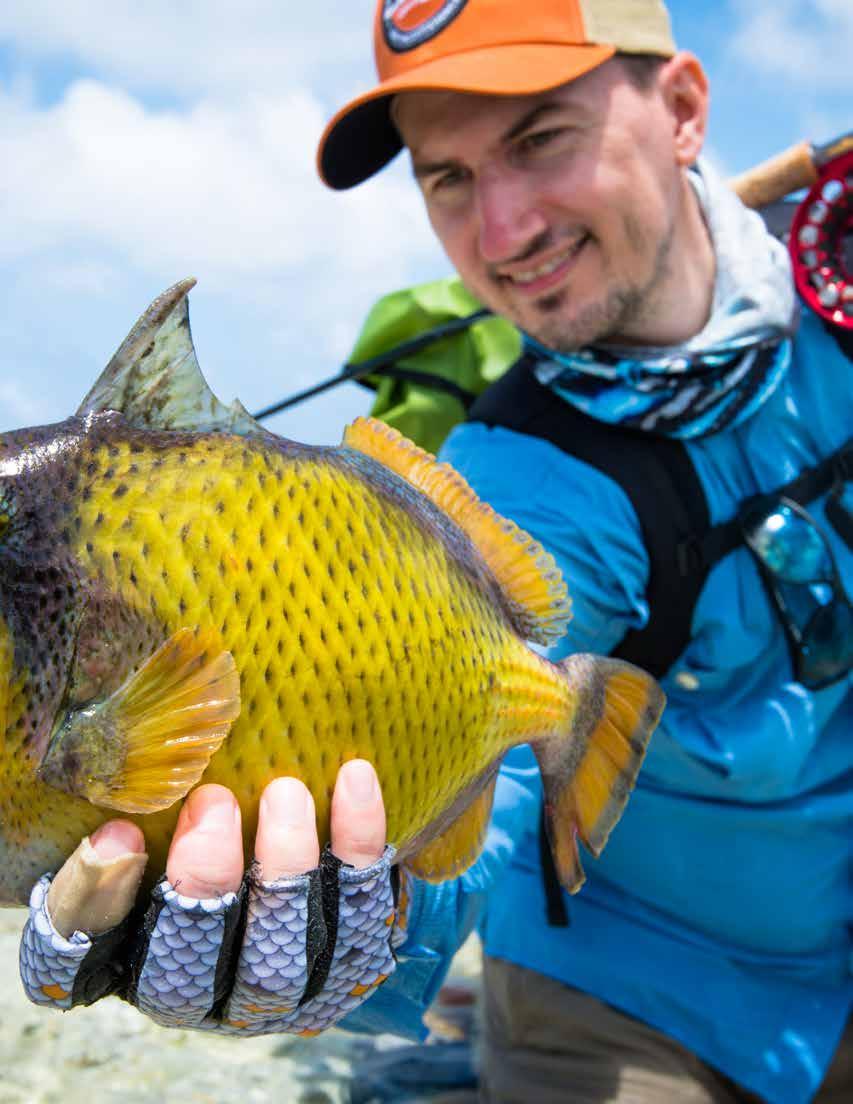
bearable as the fish get closer, and as I start the retrieve and speed up the fly with a galloping heart and feverish hands. One of the two “smaller” fish, which are probably both around 40-45 lbs, resolutely chases after the fly in a state of blatant agitation, with flaring fins and flaming eyes. Ten meters in front of me, it suddenly bursts forward and inhales the fly in an explosion of foam and water. I do as prescribed. With the rod tip low, I pull hard and resolutely on the fly line and start backing up to set the hook, but the fish just opens its bucket-sized mouth and spits the fly. In my state of bewildered agitation, my nervous hands must somehow have missed their grip on the fly line and as a result all my efforts to hook the fish have been in vain. Before I ever get a chance to put in another cast, the fish are gone! Beyond frustrated, I toss the fly rod scornfully into the water, and after having filled the air with all sorts of inappropriate curses, I stand there on the flat, completely disillusioned in total silence with the taste of blood in my mouth, trembling nerves, a hoarse staccato-like breath and a heart that rages blindly behind the skeletal bars of my chest.
It’s with a sinking heart and a minimum of confidence that we begin our last day of fishing. Here, we focus on catching one of the gold bars of the flats – an Indo-Pacific permit. These incredibly attractive and challenging fish often forage in the wake of big stingrays, which dig for crustaceans on the sand flats. During the morning, we’re fortunate enough to experience this phenomenon several times. I succeed in hooking one of these shrewd fish twice. I’m connected with the latter for about 10 minutes before the fly suddenly, and without much cause or occasion, loses its hold. The disappointment is so intense that I feel like fainting.
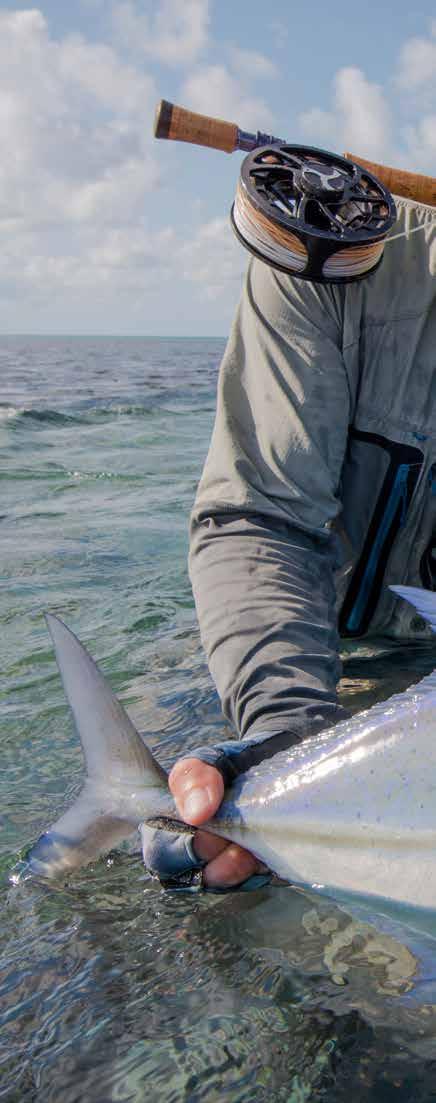
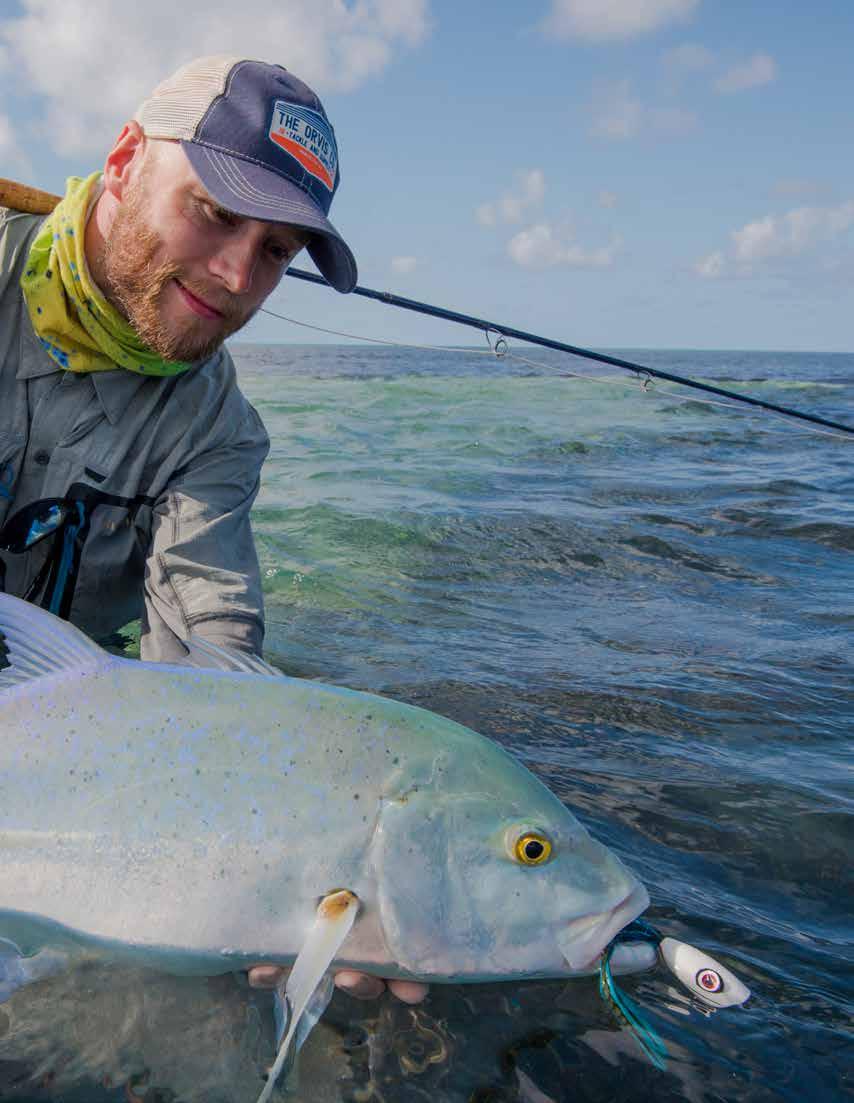

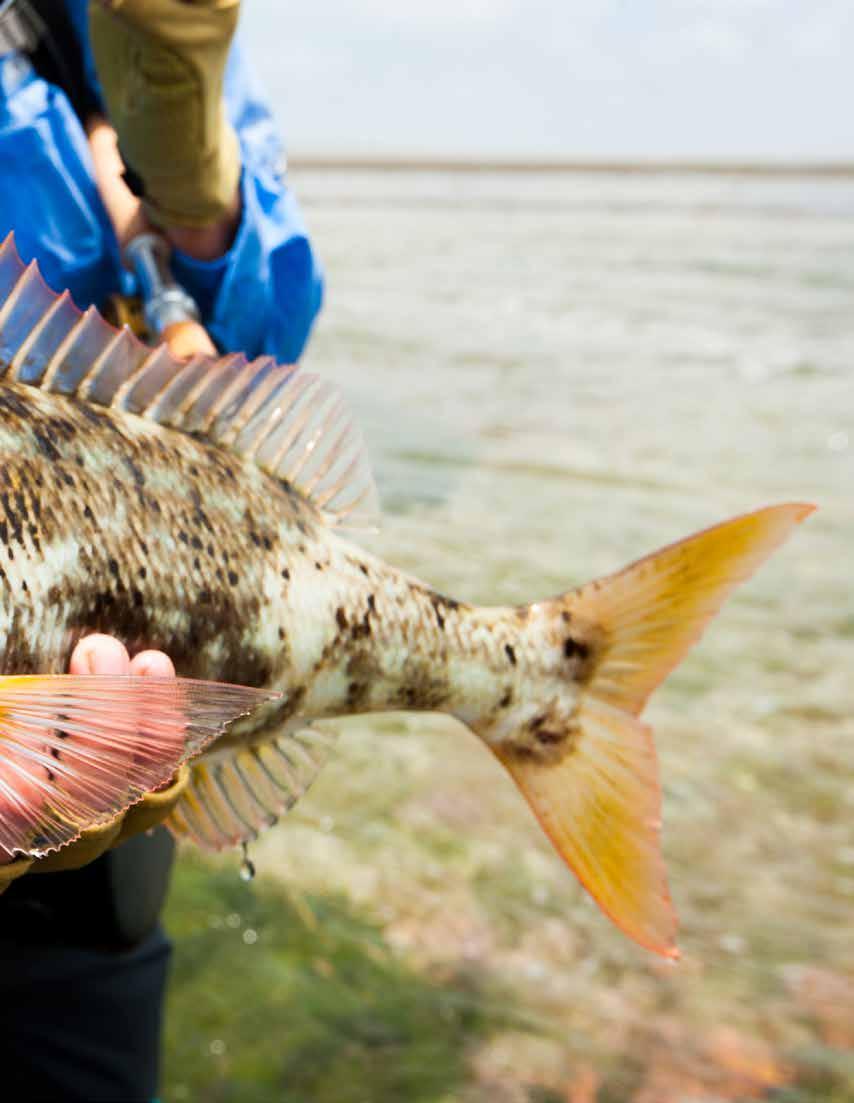
When, later in the day, the tides have gradually dried up and exposed many of the sandy flats, there are no more permit to be found, so we head for the outer reefs. Even though it’s still early in the season, and the sea is still relatively agitated, we can’t resist the temptation of locating a school of Alphonse Island’s mythical milkfish – a nervous species of fish that look like over-dimensioned mullets and fight harder and longer than any other fish. If we’re lucky, and the conditions are just right, it’s possible to trick these finicky, vegetarian fish into eating a fly.
On this particular day, we’re fortunate enough to find a big school of milkfish lazily cruising along a tidal seam that runs parallel to St. Francois western coral barrier. Our guide for the day, Wesley, shuts off the engine, jumps to the fore of the skiff with an oar, and gets us closer. Shortly after, all hell breaks loose!
I place a cast well ahead of the school and keep good contact with the green algae fly as the school passes. Shortly after, I feel a subtle tug on the line and as I lift the fly rod, the fly line immediately starts gushing through the guides of my 10-weight fly rod. The fly reel now pitches in with a tormented, flanging squeal as the reel spool spins out of control and raw amounts of fluorescent orange backing cuts through the water surface and disappears into the ocean.
Out of the corner of my eye, in a completely different direction from the one my backing has charted, I see a giant, silvery fish in the vicinity of 50 lbs thrusting itself meter-high out of the water with the fly line dragging behind. It’s as if it’s suspended mid-air unnaturally long, and it isn’t until it collides with the water again making a huge crater in a wave trough that I realize that it’s the actual fish I’ve hooked. Several meter-high jumps later, and with a backlog of about 150 meters of back-

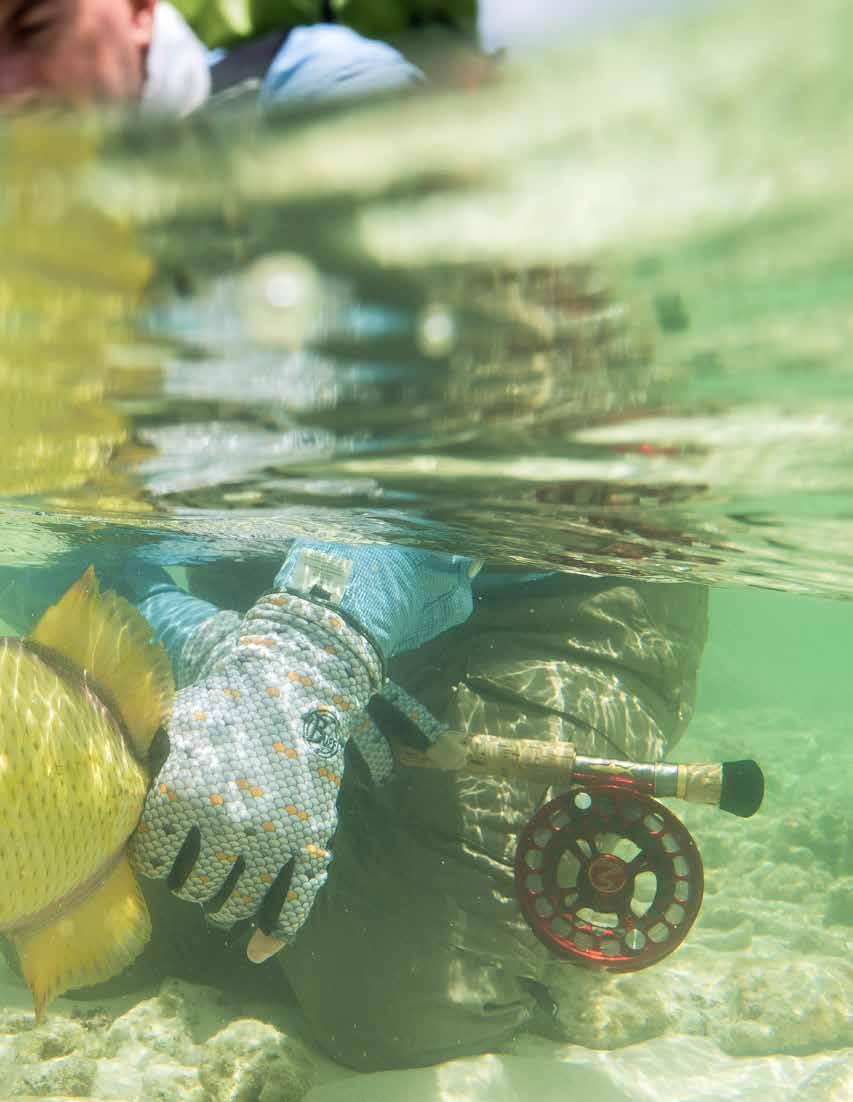
ing, the pressure on the leader and the small hook become too great. The fly loses its grip in the fish’ soft mouth, and the battle is lost. This scenario repeats itself an additional three times, and the toughest blow comes when, late in the afternoon, I lose the last milkfish of the day. A fish of a much more manageable size than the previous ones. I fight this one for a long time, long enough to actually start believing that I’ll be able to land it. When I lose this fish, nothing much is capable of consoling me. Not even the guide’s well-meaning statistic offering when he states that only one in 10 hooked milkfish are actually landed. Statistics don’t mean anything to a defeated and broken man!
Now that the day is over, the flats skiff is anchored up, and we’re on board the catamaran slowly headed towards Alphonse Island, a burning sense of failure of having missed out on a unique opportunity raging relentlessly inside me.
And whilst my fingers minutely work their way across the keyboard as I write these passages, far away from the Seychelles in cold Northern Norway, the feeling comes to life again. But now it is diluted by time and distance, giving way to deep-felt appreciation for having experienced such a heartbreakingly beautiful destination and such a unique and breathtakingly exciting fishery.
The challenge no longer consists in mending my wounds but finding a way to plan and finance another trip to Alphonse Island and the St. Francois Atoll. I’m yearning to get back there with all my heart and soul, and I’m confident that I will regain what was lost there!
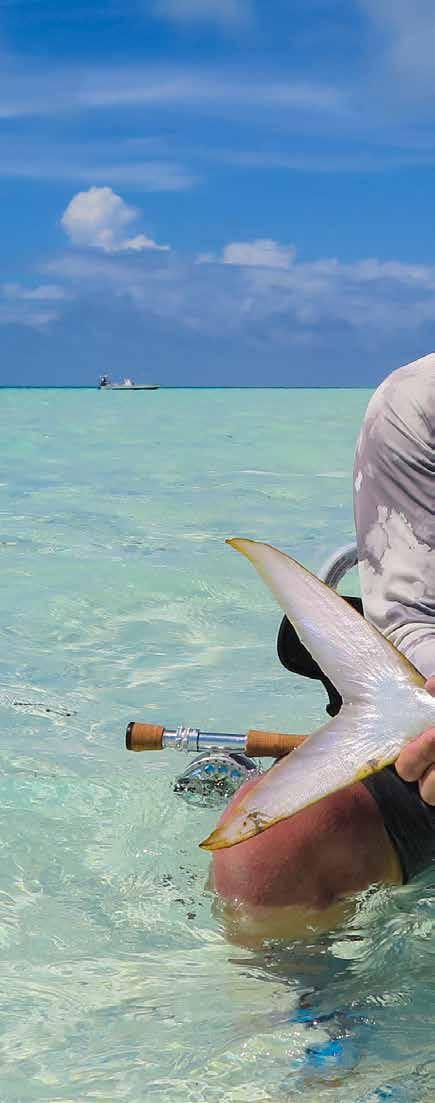

Fact file – Alphonse Island and the Seychelles
Alphonse Island is situated in the Indian Ocean some 400 kilometers southwest of Mahé, which is the main island in the Seychelles. The resort caters up to 12 fortunate fly fishing guests – and in addition to being spoiled with service and cuisine in a league of its own, they are treated to some of the world’s best and most diverse tropical fishing. It is possible to fish on your own along Alphonse Island’s flats with good results, but the guided fishing takes place around the St. Francois Atoll, which offers varied hunting grounds in the form of flats, coral reefs, tidal currents, and drop offs. You’re transported to St. Francois on a catamaran and will subsequently get on board one of the flats skiffs that are anchored up there. Once there, you’ll find massive schools of fully grown bonefish, plenty of Indo-Pacific permit, trigger fish (Yellow margin, Moustache and Picasso), milkfish and giant trevally – in addition to snappers, bluefin trevally, brassy trevally, groupers, bonito, parrotfish, nurse sharks and much, much more.
If you’re interested in booking a trip to Alphonse Island, or some of the other renowned Alphonse Fishing Co destinations in the Seychelles – including Cosmoledo and Astove, send an email to: reservations2@alphonsefishingco.com
For further information, be sure to check out these links: http://www.alphonsefishingco.com http://www.seychelles.travel/
For more information on fly fishing destiations, check out Rasmus Ovesen and Martin Ejler Olsen’ s publication In the Loop a free online magazine featuring the very best in Fly Fishing Photojournalism. https://intheloopmag.com


by Justin Spence
Big Sky Anglers
In May 2024 several buddies and I had the opportunity to explore some amazing fishing in Papua New Guinea (PNG). I first read about fishing in PNG in an article Lefty Kreh wrote years ago in which he talked about targeting PNG’s black bass on a fly. Ever since reading Lefty’s article, I had PNG on my shortlist of places I really wanted to try. Little did I know what an exciting fishing adventure awaited me in an exotic setting few anglers had visited or even heard about. The fishing would be incredible, but quite unexpectedly, so would the culture.
Let me try to explain why very few fly fishermen travel to Papua New Guinea, and then, why I’m so grateful I became one of those lucky few. Located north of Australia, PNG comprises the eastern half of the island New Guinea. Almost half of the 17 million people who live in this country are subsistence farmers living in customary communities that remain viable units of society and are recognized as such in New Guinea’s Constitution. These indigenous communities live on their land, not through any legal deed or title, but in accordance with their own customs, and control over 90% of PNG’s land. One consequence of having 600 recognized different communities is that there are 800+ known languages spoken in this country, making it the most linguistically diverse country in the world! Throughout the country, each of the indigenous groups protects its local community and defends itself against its neighbors. This hodgepodge of so many separate authorities and customs makes it difficult and even at times dangerous to navigate and scout out places to fish on your own, as you might in New Zealand or Australia.
To overcome those obstacles, I was fortunate to have found BAIA FISHING LODGE, owned and
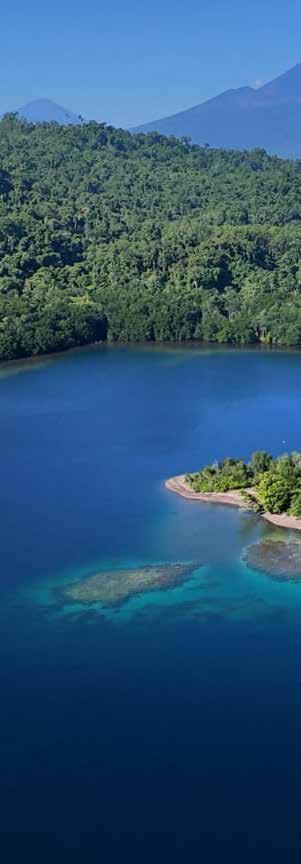

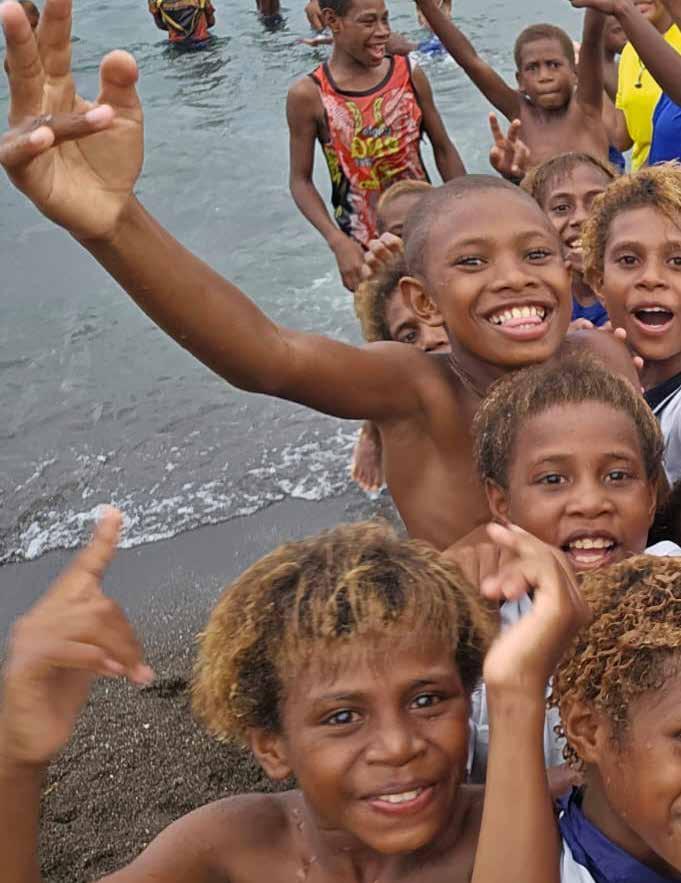

operated by the Reimann Family. The Reimann’s are a well-established multi-generation family who own several different businesses surrounding the town of Kimbe, West New Britain, PNG. Over the past several decades, their passion for fishing has led them to build a fishing lodge in the remote village of Baia, a four-hour boat ride from Kimbe, and to purchase a “live-aboard” yacht that offers weeklong exploratory adventures throughout PNG. Our host, Tiana Riemann, grew up in Kimbe, having first-hand experience with the freshwater rivers and surrounding ocean. With her grandfather and dad, both passionate anglers, Tiana explored and scouted out great fishing locales. As an added asset, Tiana learned the local language and key aspects of their culture while attending elementary school in Kimbe. Later, she moved to Australia where she completed her schooling. After spending several years in the more modern, Brisbane, Australia, she realized her true passion for life was back in PNG, fishing, guiding, and helping run the family fishing enterprise. Not only did she put us on some great waters; but also, she lifted the curtain on a fascinating culture in PNG, greatly enriching our angling adventure.
We departed Brisbane Australia for Port Moresby on Air Niugini, national airline of PNG. Once in Port Moresby, capital of PNG, we transferred to the domestic airport and caught another Air Niugini flight to Kimbe, West New Britain. When we arrived in Kimbe we were greeted by Tianna and her team. After flying into the town of Kimbe and spending the night at Liamo Reef Resort, we departed on our four-hour boat ride to our lodge, located a whole 30 yards from the ocean! There, BAIA FISHING LODGE offered all the amenities for a comfortable week-long stay. Each morning following breakfast, we departed on a 20ft saltwater panga to explore the freshwater rivers and the wide-open southwest pacific. Our guides, natives of Baia, spoke sufficient English…enough to point out the right spots to




cast (and not)! The guides were not familiar with fly fishing but were very enthusiastic, as I showed them what a fly rod could do.
As a group, we landed over two dozen different fish species. Most of the fishing in the rivers was blind casting with sink tip lines and 9-10wt rods. The river mouths and ocean provided sight casting opportunities for Gt’s and tuna. Our daily catches included Black Bass, Spotted Bass, Brim, Giant Trevally, Blue Fin Trevally, tarpon, cod, mackerel, Coral Trout, and several types of tuna. Toward the end of our week, thousands of white bait moved into the river mouths bringing Gt’s, tarpon, and bass after them for a feeding frenzy. PNG offered an incredible variety of fish…show-stopping beautiful and great fun to catch.
Fishing in such a remote place really made me think about how different our varied worlds are. The village people in PNG live such a unique life, socially and culturally, and basically unchanged over the last five thousand years! The land and ocean provide their food locally for the most part. Public education and healthcare barely exist in most of PNG. These folks live a life with few material possessions yet appear to be happy and content. Once again, on this trip, I realized fishing is such a fantastic way to see the most unique and unspoiled parts of the world. Parts, I would probably never visit otherwise. Fly fishing in PNG far exceeded all my personal expectations to say the least. In fact, I should add that fishing in PNG is a unique experience anyone might want to try .
For anyone wanting to explore PNG, I highly recommend Tiana and her family at BAIA FISHING LODGE. She is not only an incredible angler, captain, lodge manager, but is closely connected to the people and country. My tremendous experience in PNG would not have been possible without a family like Tianna’s. Many thanks to the Riemann family!
BAIA Fishing Lodge, West New Britain Island, PNG

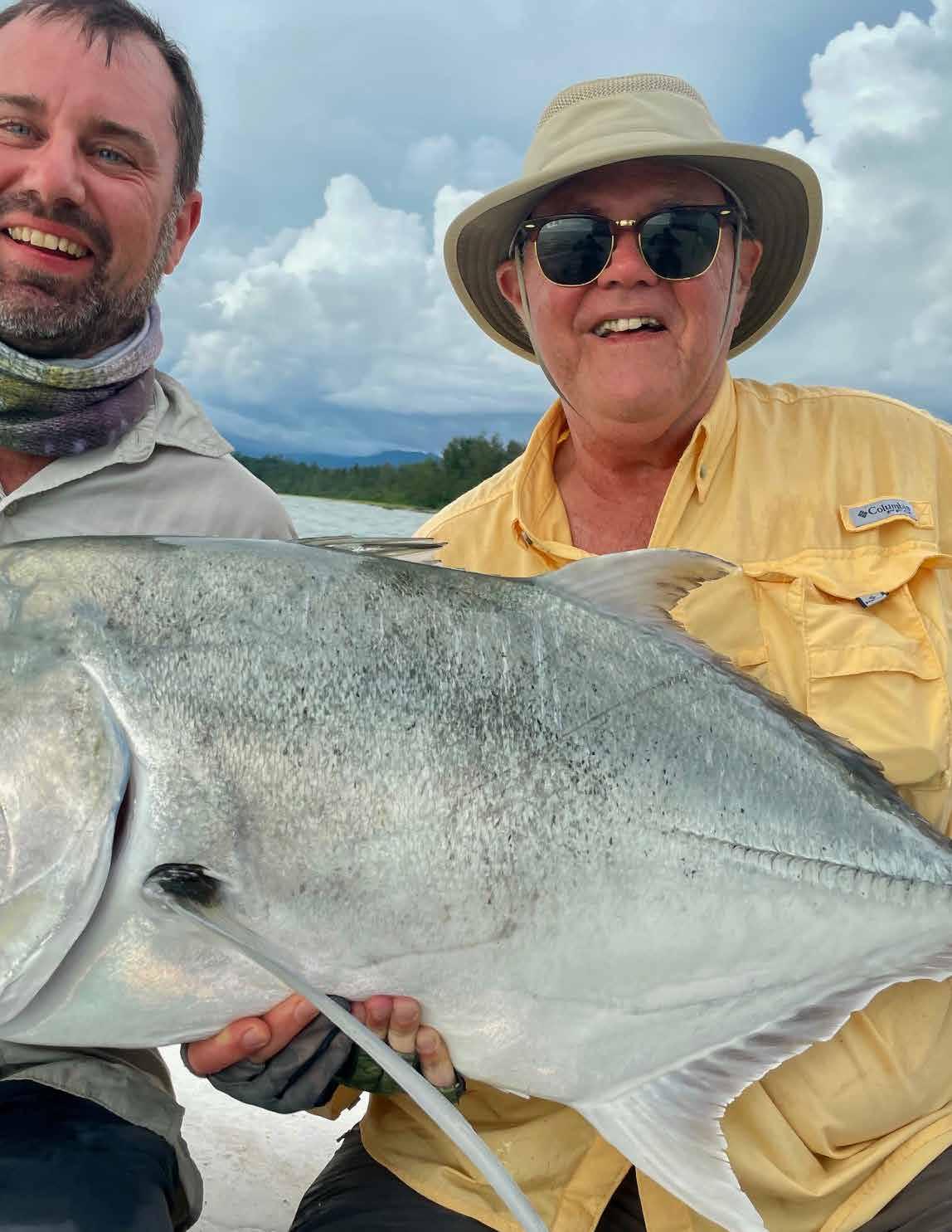
by Gary Geddes
I recently spent a week fishing the crystalline waters of the Sea of Cortez with the goal of getting a roosterfish on the fly. This was my third attempt to the Baja East Cape and fortune was finally on me.
Upon arrival, I met up with my guide – Jeff DeBrown of The Reel Baja – who said there were many schools of roosters bashing bait balls all along the beach. The ultimate is to get one in the surf, but the fish were staying maddeningly out of reach for shore-based anglers so we took to a panga to pursue the constantly moving blitzes.
I was fishing EP Pacific Sardina patterns on a Sage10wt with Rio Outbound Short IS line. It was fast action requiring long accurate casts to these speedy predators. And after the cast you had to strip like crazy, any pause would immediately turn off the fish. In addition to the roosters there were many dorado (aka mahi), jacks, and lady fish eager to hammer the fly. It seemed we were never more than a few minutes between hook ups, what a blast!
Jeff, an Orvis Endorsed guide, provided excellent coaching in casting, stripping, and fighting these tough fish. My accommodations at The Buena Vista Resort, roughly an hour up the coast from the Los Cabos airport, were comfortable and staff was warm and friendly. I am already planning for next year. Learn more at TheReelBaja.com.


by Bill Bruglehall
Warning! This article contains conventional tackle references and images.
This past summer I took the opportunity to spend about a month in my state of origin, Florida. My plan was to split my time working from a friend’s house while spending my free time exploring as many fishing spots as possible. As a Floridian by birth, the prospect of casting fly-line in my home waters had me feeling like a kid again. I imagined hauling in monster Largemouth Bass caught on poppers and streamers as I showed my conventional tackle slinging friends what I could accomplish with a fly rod and my own hand-tied flies. By the end of the trip, I would be both humbled and enlightened.
Parrish is a relatively quiet town in west Central Florida south of Tampa and is home to Brent, one of my best friends from the Army. We met in 1991 at my first duty station at Finthen Army Airfield, Mainz, Germany. Brent is a Civil Engineer that specializes in hydrology and has always been drawn to water however he can get at it. He is also a seasoned sailor who is invited to join sailing crews and race in the Mackinaw every year, his birth-right as a native Michigander and son of a sailing family. He is also a fly angler and lover of nature like me, so it is no surprise that his neighborhood was designed so that every house is “waterfront property”. I put that in quotes because waterfront property is not always what you imagine. Brent’s neighborhood is designed like many others in Florida with clusters of houses surrounding small retention ponds designed to promote settling and cooling of turbid runoff water before it flows into the nearby tribu-
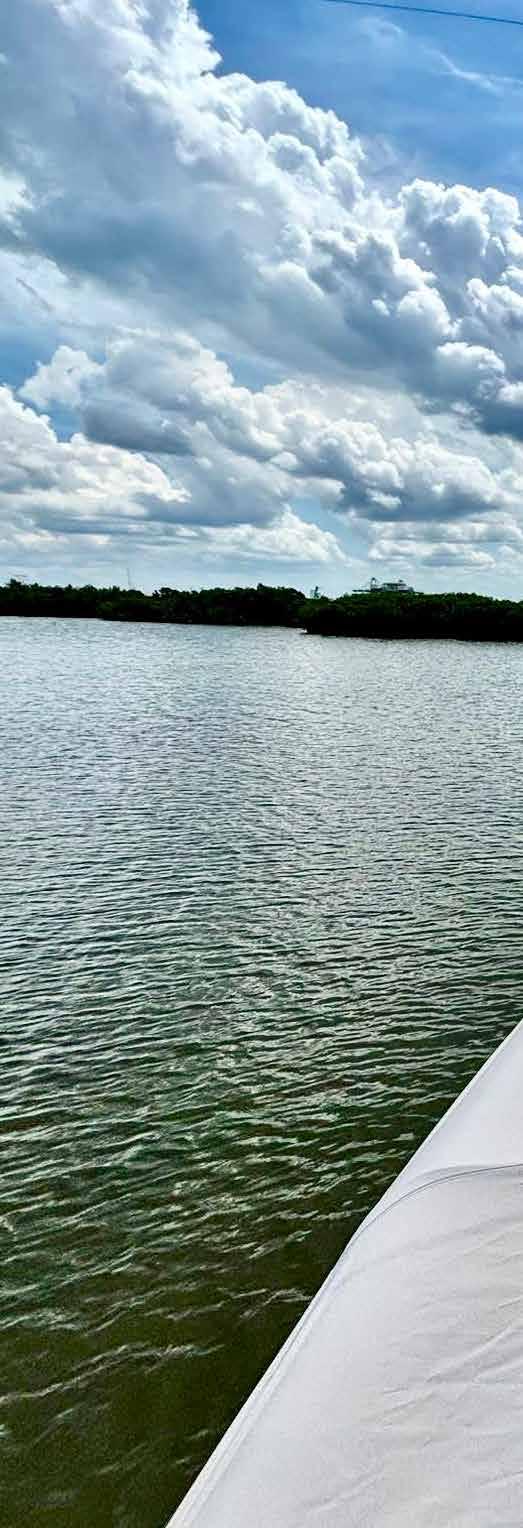
List of Species Caught
Sunfish (Fly rod) Red Grouper (Conventional)
S Grouper (Conventional)
Nurse Shark (Conventional)
Scallops (Hand)

Casting from a flats-skiff in Crystal River, Florida
taries. Initially my thought was that this little pond would not hold any good fish, I was wrong in my assumption.
As I sat in Brent’s kitchen working that first Monday morning, I glanced over my shoulder and noticed concentric circles forming on the water’s surface everywhere in the pond. I assumed that it was small fish coming to the surface to feed on whatever buggy things were floating there. I watched this activity for a while with curiosity until I was surprised by an explosion of top water activity in the center of the pond near the aerator. I assume it was a Florida Largemouth bass but knew it was big and hungry. I spent the next two weeks pursuing those big fish from the banks of the pond.
Most of the fish I hooked up on in that pond and all the fish I landed were very aggressive Bluegill both large for their species and the most amazing dark purple color. One morning, while alternating between small top-water flies for the hungry Bluegill and streamers or poppers for the Bass, a huge Carp rolled about 5 feet from where I was standing. I immediately went in and tied some Carp flies. Over the next two weeks at Brent’s house, I stalked that monster Carp and the Bass I saw feeding in the middle of the pond. I hooked up on the beastly Carp once using my 6-weight Moonshine Drifter right near the shore where I originally saw it, but it broke me off shortly after I set the hook. I knew then that I would need heavier gear here in Florida.
If you haven’t explored the Gulf coast of Florida, you’re missing out of one of the United States hidden gems. This stretch of coastline offers some of the best fishing and most beautiful beaches the lower 48 and possibly the world. If you ask a Florida fisherman where to fish on the west coast, Homosassa will be on their short list. The town offers
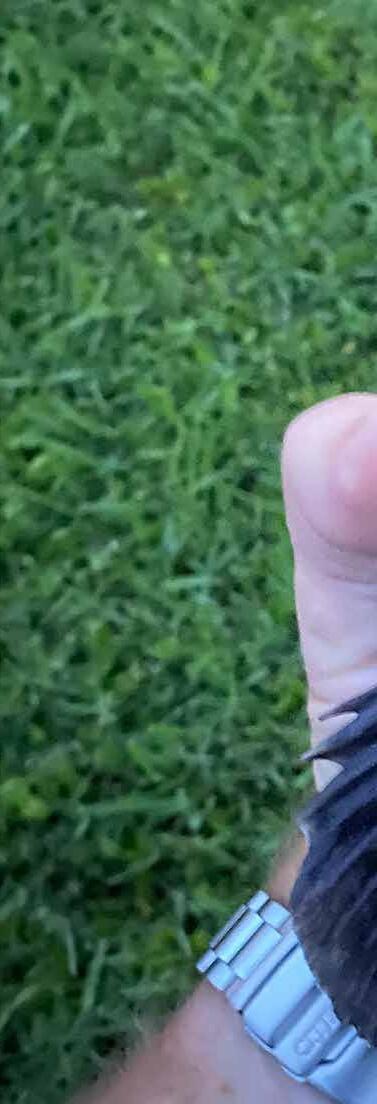

very little in the way of non-fishing tourist attractions which makes it a great place to explore the beautiful spring-fed Homosassa River while providing easy access to the Gulf of Mexico for fishing from a flats-skiff or a “mud-boat” (a specialized boat designed for getting into extremely skinny water).
For this quick trip I linked up with Russ, a serial entrepreneur, and friend of mine since the second grade. Russ lives in Ocala Florida about 20 minutes from where we grew up on Lake Weir. Russ has a great little bay boat made by Action Craft before they ceased operations. Action Craft got back into the boat building business in 2023 after being acquired by Mocama Marine. This trip fell in my lap, so I was not prepared and didn’t even have my fly-fishing gear with me.
Russ and I launched his boat at his brother’s condo complex on the Homosassa River close to the spring head and made the 30 run out to the gulf then a quick turn off the channel to the shallower waters where several small mangrove islands dot the emerald, green flats. We used live shrimp as bait on conventional tackle and caught a few Grunts with Russ catching one a small Redfish. I took notes and planned to tie or find some shrimp imitation flies to use when I came back to the gulf with my fly gear.
Crystal River, Florida - Conventional Tackle versus Fly Fishing
Fly fishing is my passion now and what I would rather be writing about, but when someone offers to take me out 50 miles into the Gulf of Mexico to hunt grouper, hog fish, and other deep-water species I won’t pass it up. After returning to Brent’s house to regroup from my Homosassa trip with Russ, Brent mentioned that he had a hotel reservation at the Plantation Resort in Crystal River, which another friend of ours from the army backed out
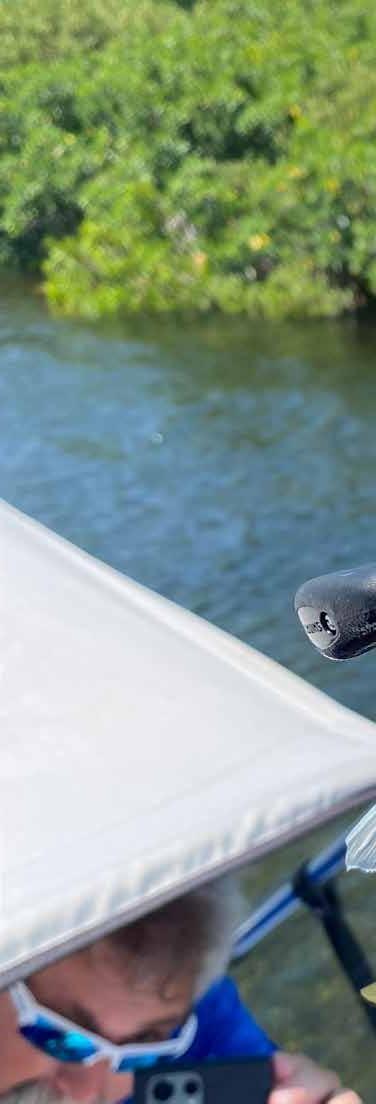

of. I called Russ to see if he would be interested in meeting us there the next weekend. Russ was game and told me that his business partner, Jason, has a year-around RV site at Crystal River RV Resort, a good-sized bay boat, and Captain’s License to boot. The only logical thing to do was to go up there and do some Gulf fishing.
We met everyone up at a place called Waterfront Social & Tiki Bar to shore up the plans for fishing the next day. The food at Waterfront Social is good and it is located on King’s Bay so you can sit right on the water and watch the boats come back in from fishing. After introductions and a good meal, we had our plan set for meeting up at 8am to launch the boat right there at Jason’s RV resort boat ramp. Having private boat ramp access is the key to launching boats on the Gulf coast of Florida, especially during Scallop season! If you must use a public boat ramp, be prepared to get there very early to wait in line to launch. At Jason’s private ramp, we got to the ramp at 9am and only had one boat launching ahead of us.
The trip out of Crystal River to the gulf is much shorter and faster than at Homosassa so we were in open water in no time. Jason had a bunch of GPS points saved that he got from a friend of his who recently gave up his Saltwater fishing guide business to move out of state. We fished multiple spots as we headed out to deeper water. In the Gulf of Mexico, it is easy to figure out how deep the water will be as you travel out because the ratio is one foot of drop per mile offshore. Jason’s goal for the day was to catch “keeper” Red Grouper and Hogfish. Keepable Red Grouper in Florida are 20 inches in “State Waters” (up to 3 miles out) and 24 inches in “Federal Waters” (greater than 3 miles out up to 200 miles) with a two-per-person limit. Jason informed us that it is a $350+ fine per fish under the size limit and sometime fish shrink a little after you put them on ice, he learned this from experience.


We hopped from spot to spot until we reached 50 miles out, fishing with shrimp and Pin fish, which everything wanted to eat. Along the way we caught too many Grunts to count and kept a bunch of bigger ones at first incase it was all we caught that was keepable. We landed many undersized Red Grouper and a several large Grey Grouper that were unfortunately out of season. Jason caught his prized Hogfish which he says is the best tasting fish there is. I even hooked and landed a Nurse Shark which took me what seemed like at least 10 minutes or longer to haul up from 50 feet down. I was hoping for a monster Red Fish and was surprised when a four-foot-long shark came into view. Jason asked me if I wanted it in the boat to take a picture with it and I was more than willing. Once in the boat, it took me a while to tire the shark enough for a picture and I have a fun video of that. The only way I can describe the experience is that it is like arm wrestling with someone’s leg. Unfortunately, no one got a good high-definition picture for this newsletter, but if anyone is interested in seeing the video let me know!
The next day, Russ, Brent, and I went out to the flats in Russ’ boat so I could try my hand at fly fishing around some of the Gulf Coast Mangrove islands just outside the mouth of Crystal River near the old decommissioned nuclear power plant. The plant has since been converted to burn coal that is shipped in on barges, talk about going backwards in technology! For this trip I bought an inexpensive 8-weight flyrod/reel combo from Bass Pro Shop in Tampa along with some baitfish, crab, and shrimp pattern flies. I had a lot of fun trying to hook one of those red fish that Russ caught previously on conventional tackle, as well as some sting rays that were cruising the sand bars. I was sure I would get something that day but ended up getting skunked, which is never fun to have to admit. The trip was
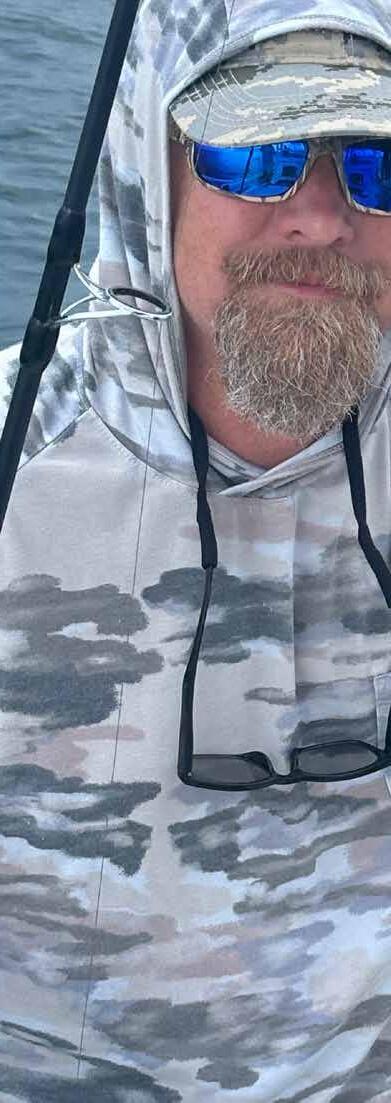
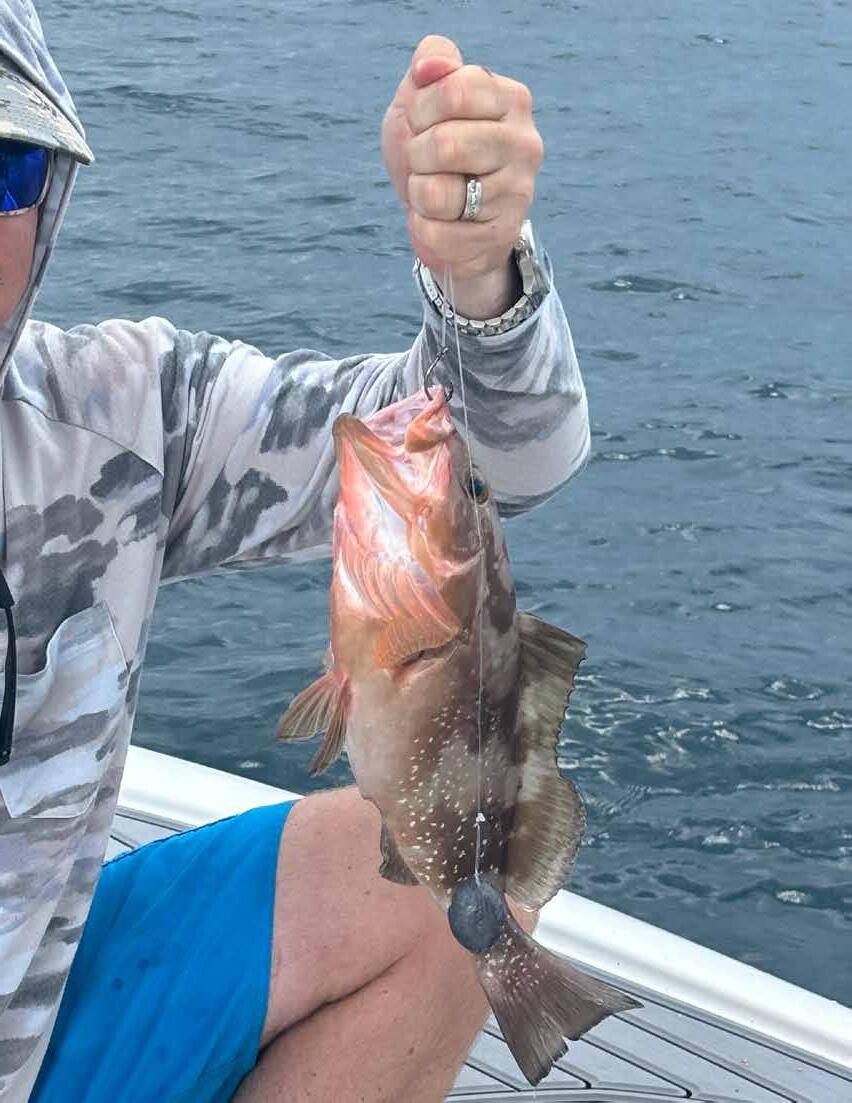
not a waist though, as I honed the essential skills of casting in wind off the front of a skiff. Next time I go to Florida I will do more research and maybe even hire a Florida fly fishing guide.
The weekend before heading back to Texas, my sister, Amy, her boyfriend, Billy, and I went to Steinhatchee to do some scalloping since it was in season. They parked their RV right next to the river and I stayed at the Steinhatchee Inn right across the street. The inn was not fancy but nothing much in Steinhatchee is. The inn is also the proprietor of the RV spots and has a co-located marina for convenience as do all the other lodgings along the river there. Steinhatchee is known for being a little more backwoods than other Florida Gulf Coast towns.
I brought my fly-fishing gear hoping to catch something in salt water before leaving Florida. I did some fishing at the docks on the river where we were staying with no luck. One of Billy’s childhood friends, Ed, was also staying there that weekend with his kids and their assorted families, so they rented a house on one of the many tidal creeks there. The first night there we went to visit Ed and his family at the rental house, and I was excited to see that the tidal creeks held fish and Ed’s sons were trying to catch them of a small dock with no luck. I cast Woolly-Buggers into to the brown-stained water off the small dock for a little while thinking I could land a new species in this interesting creek.
To my dismay, I kept getting broke off, and then I noticed that the fish were Gar, and that explained it. Luckly, I just happened to have a couple rope flies that I originally tied to catch Gar on Lake Georgetown, Texas. I tied one of the rope flies onto 1x tippet on my 8-weight pole. To get a better angle for casting, I waded out into the creek just upstream from the dock on a shelf of Florida limestone that


On sand bar near Crystal River Power Plant trying to figure out what Stingrays eat.

Jason with a keepable but out-of- season Gag “Grey” Grouper.
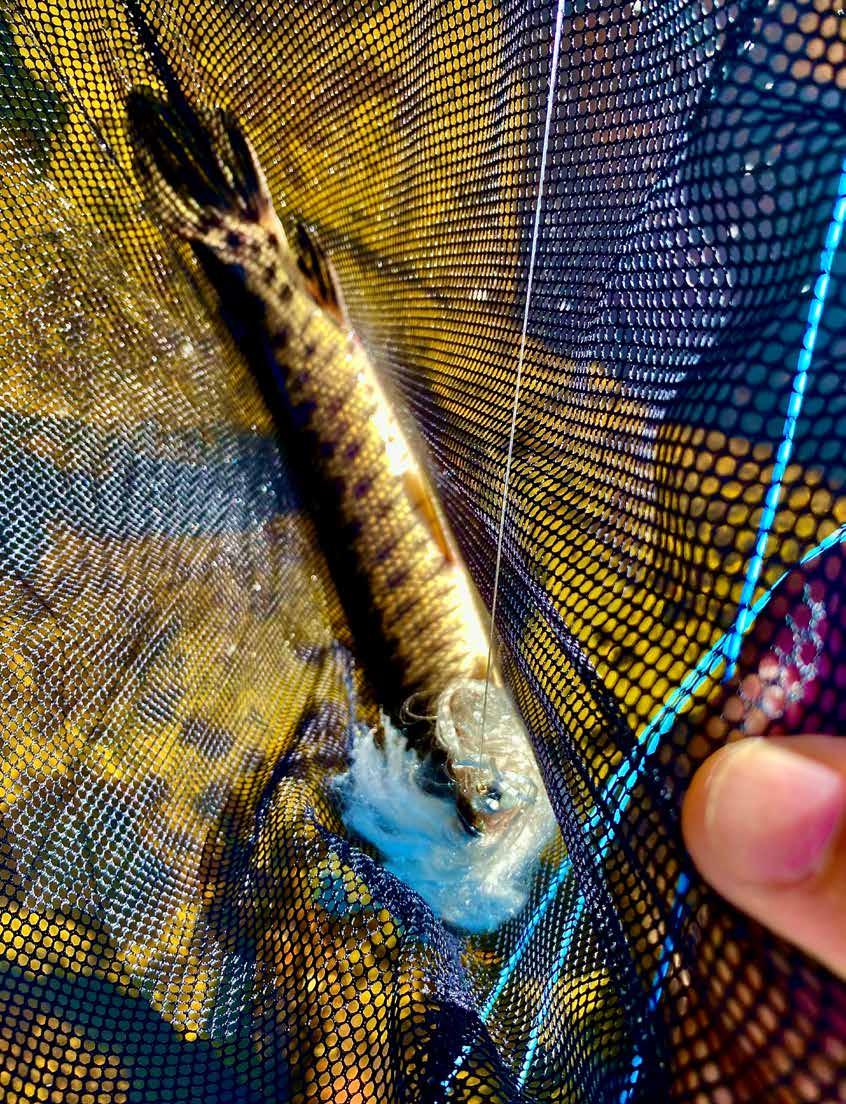
was submerged about six to twelve inches under the brackish water which was flowing out fast with the tide. I made a few casts toward the bank opposite of the house and then saw a gar swimming upstream right toward me!
I gently flipped my rope fly right in front of its path and gave a couple little tugs for movement and then, to my surprise, it bit and then it rolled, as Gar will do. I had it tangled up in the rope fly’s fibers and gently pulled it in close. I was ecstatic but tried to control my emotion as I leaned over to net it in the swift water. You don’t want to just grab a Gar with all those teeth. I never had any luck with the big Gar in Texas, but I can now say I successfully netted a 20-inch Florida/Spotted Gar. The Florida Gar can reach lengths of 50+ inches so mine was small for the species, but I am very happy to have caught this fish since it is rarely found in brackish water. It still makes my heart race thinking of site casting to that fish, and I will never forget it.
Conclusion
I learned a lot about fly fishing in Florida on this trip. One thing I learned was that you can catch interesting fish everywhere there, whether it is a small neighborhood pond or a tidal creek in the bug infested backwoods of the Gulf coast. Another thing is that it will take many trips to figure it out as there are so many different environments to fish all within an hour or two drive from my hometown. Lastly is that I am very excited to get back to Florida during the winter when the bass fishing really turns on where I grew up on Lake Weir. I tried fishing there this trip but only caught a few unimpressive sunfish in the oppressive summer heat despite my many attempts at fly fishing from a SUP behind my sister’s house. Perhaps I will bring my fishing kayak with me next time and float one of the many inland, spring-fed rivers that run through the middle of the state or do a trip down to the Florida Keys to target Bonefish and Permit. Whatever it is, I know it will be fun!


The Rio Grande in the United States or the Río Bravo in Mexico, also known as P’osoge in Tewa and Tó Ba’áadi in Navajo, is one of the principal rivers in the southwestern United States and in northern Mexico. Wikipedia
by Nick Streit
Though the Rio Grande in New Mexico, is not thought of by many as a fly fishing destination, its fishing and popularity have been on the rise in recent years. Here are some tips for a successful trip.
Pay close attention to conditions
Unlike many other popular western rivers, the Rio Grande in NM is not controlled by dam release, leaving flows, water temps and water clarity to vary greatly over the year. Understanding what makes for good conditions will make or break your trip. Typically, the best timing to hit conditions perfectly are in the fall, when the river runs low, clear and cool. But you want to check flows and weather before any day on the Rio, and calling a local fly shop or guide before your trip is a good idea.
Know your limitations
The majority of the river runs through a dramatic gorge, up to 1,000 vertical feet and features rough, rocky banks. While these factors help ensure solitude on the water, biting off more than you can chew can make for a miserable to even dangerous day.
Fish big stuff
This is not the San Juan! Leave the 6x tippet and size 20 flies in the truck. Catching fish on the Rio is much more about identifying good holding water and a good presentation than having the right fly. And because fish are not caught often in the depths of the canyon, they are typically fooled with a bigger, brighter fly – which helps to cover more water as well.



Of all the places we send folks to fish in the area, the Rio Grande is the one that trips up anglers the most. Outside of help with access, it’s a unique river and its many nuances will not be figured out in a day or two. Having a professional along will greatly improve your odds of success. It also opens up the possibility of floating the river, either for the day or on a more adventurous multi day trip through the box.
Fish a long rod- and get closer
Because of a the rocky nature of the river and the fast currents, the Rio is a high-stickers dream. Tight line and Euro techniques work very well here, and a longer rod 9”-10” help to get the drift in the harder to reach spots.
Taos fly shop www.taosflyshop.com 575-751-1312


byJim Gray
I first heard about the Georgia Bass Slam from Ben Patrick, a Georgia transplant and one of my friends and regular fishing partners. He would talk about these species of bass that I’d never heard of, and occasionally send me pictures of fish posted on social media. Georgia recognizes 10 native species of bass - LBM, SMB, Spotted, Shoal, Suwannee, Redeye, Chattahoochee, Tallapoosa, Altamaha, Bartrams. To achieve the slam, you have to catch 5 of the 10 species in a calendar year.
Getting 5 species is very doable, but not as easy as you might think. While some fish are common and widespread, more than half are either rare, or come from a limited water shed. There’s also a lot of hybridization between the spotted bass and the other species, increasing the challenge. Since hearing about the slam, I’ve been thinking about a trip to Georgia to see if I could make it happen.
That opportunity came earlier this year. Ben was off on his teacher’s summer break, and had returned to Georgia to spend some time with his family. I was driving my wife to North Carolina for a two week art course and would have 10 days of “free time” before she would be finished. I decided to fish a couple of days in North Carolina for smallmouth and rock bass, and then meet up with Ben to target three fish - shoal bass, spotted bass and redeye bass.
Our plan was to meet in N. Georgia, and float a stretch of the Upper Chattahoochee River targeting shoalies. After that we would drive south to Dahlonega and use that a home base for fishing the Etowah, Chestatee and Yahoola in search of spotted and redeye bass. I knew a largemouth was pretty much a guarantee, but I would need some luck to find the 5th species and achieve the slam.


Day 1 on the Chattahoochee River was an adventure. Our plan was to kayak section 3, but after talking to the rafting outfitter at the take-out, we decided to kayak Section 4. It was an easy decision after the rafting guide looked at my kayak and said when I asked him if my kayak was up to the task“I might have done that 20 years ago if I’d had a lot to drink”. He went on to tell us that Section 4 had a few challenging spots, but if we stayed to the left, we should be alright. With high hopes for a big fish day, we pushed off.
Before we were out of sight of the outfitters, we came to first set of shoals. Ben went first, staying to the left and immediately flipped his boat and was pressed up against some trees in the water. Fortunately, the water was pretty shallow and Ben was able to get his feet under him and get out of the jam. He retrieved his boat, but had lost his fly rod. It was a humbling lesson that we would need to be very careful for the rest of day.
Due to the fast current, our only choice was to head downstream and complete the 5 mile float. It turns out that set of rapids was one of the smaller ones, and we would be challenged many times before the day was over. Our Texas sit-on-top kayaks are not the best choice for rivers like the upper Chattahoochee; but in their defense, they did manage to get the job done, and that first flip over was the only one that day.
It was difficult to fish from the kayak because of the rapid current. The most effective fishing technique was to get out of the kayaks on the rocks at the top of the shoals and fish from there. After a few hours of trial and error, we started to find a pattern that worked, and we were picking up some nice shoal bass. What was turning into a good day of fishing was cut short by a huge thunderstorm with high winds, heavy rain and frequent lightning. This section of the river is very remote, so our only option

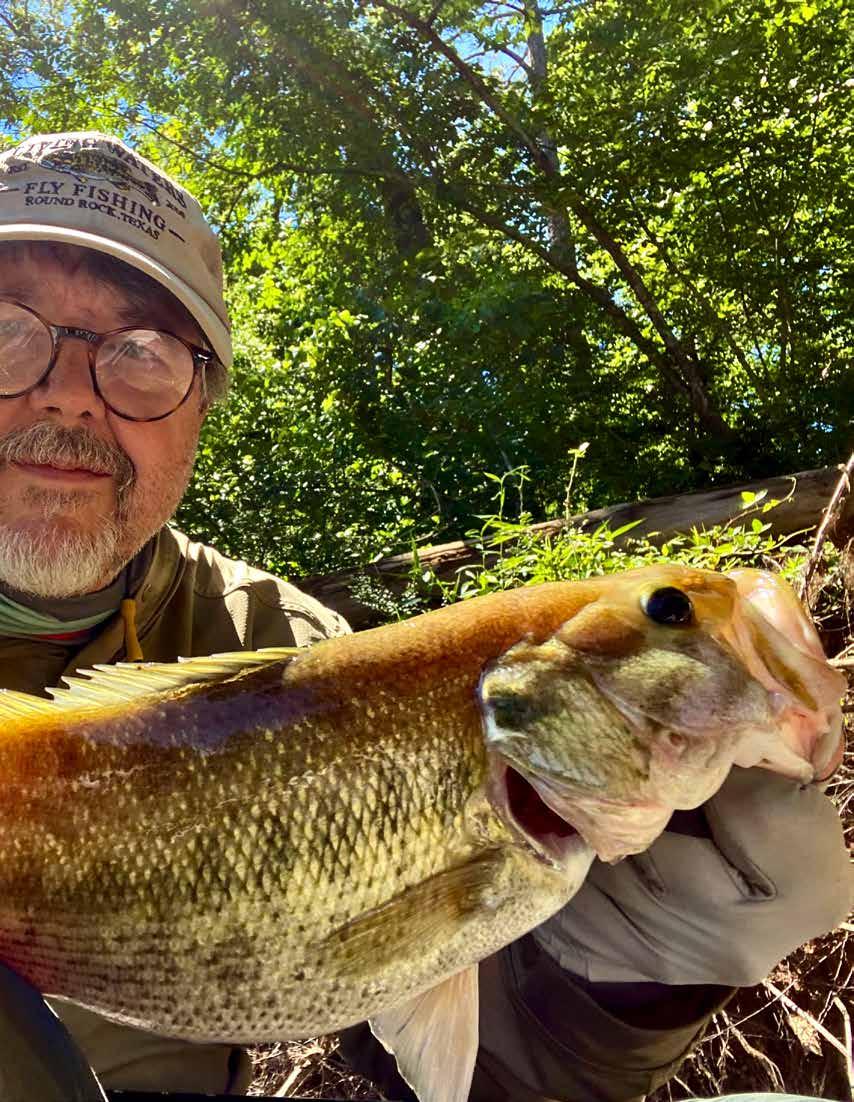
was to hunker down and wait it out. By the time the storm blew itself out, the river had turned to chocolate milk and we made our way to the takeout. In hindsight, it was great fun, but kayaking unknown waters with multiple complex class IV rapids while fly fishing from sit-on-tops may not be the best idea.
With the Chattahoochee blown out, and shoal bass checked off our list, we shifted our focus to the rivers around Dahlonega. The next 8 days were less eventful, but still rewarding. Mostly, we caught spotted bass, largemouth, a few more shoal bass, along with lots of big sunfish, yellow perch, crappie and even a few carp. When we needed a break, we would shift to wading for a day. Yahoola Creek proved to be a great wading spot with lots of small fish, and an occasional specimen.
The Chestatee was similar to the Chattahoochee in size. It’s a fast river, but runs through flatter terrain, so you don’t have the rapids. You do have shoals, and can catch some shoal bass from this stretch.
The fish I was most excited about was the redeye bass. With only 2 days to go, I still hadn’t caught one. Ben suggested we fish the Etowah since it would give us the best shot. On the next to the last day, I caught a very small redeye, and followed that up with a very nice redeye on the last day. It was a great ending to the trip.
In the end, I fell just short of the 5 species I needed for the slam. I always knew it would be difficult given the limited range we were fishing. To make it happen, you need to put in time on the water, and target multiple river watersheds. To give you an idea of the difficulty, in 2023, less than 50 anglers were recognized for the slam, and only 7 anglers caught all 10 species. I’m not too disappointed, since now I have a reason to go back.
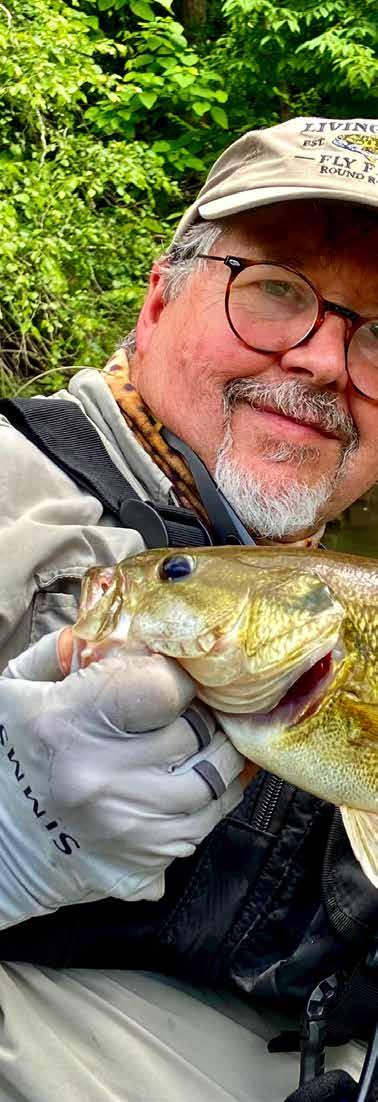


The rivers of N. Georgia are beautiful. Clear water, running over rock and gravel through remote valleys. Even in the flatter stretches, the water was much faster than I expected, making it difficult to fish from a kayak. During our trip the water was low. I can only imagine what it would be like after a wet spring. Overall, I would say the fishing was challenging. Ben and I averaged 8 - 10 bass apiece on each float. I mentioned this to a fly shop owner who frequently fishes the rivers, and he said that 10 bass is a pretty good day. I don’t think big numbers of fish are common. You have to work for these fish, but it’s very rewarding when you catch a quality specimen.

Originally named the Río de los Brazos de Dios by the early Spanish explorers
by Nils Pearson
On the third Thursday in August, Will Herring and Jordan Marsh came to the Austin Fly Fishers membership meeting to present their Brazos River Fish Camp to our group. I must confess that I had never thought much about fishing this river but their presentation got me interested. So, I contacted Will and made a reservation to fish the river with him on the following Monday. I was accompanied by Brandon Rabke and Doug Kierklewski.
The camp is located about 12 miles south of Lake Whitney. Reaching their location is a bit tricky because it is located on a private road on the shore of the Brazos. They have a main house where they reside, a cabin is available for fishermen spending the night and excellent meals are provided.
Before I go any further, I must admit that I am no fan of airboats. Often when I am fishing the flats on the coast, some half-wit comes roaring by in an airboat flying right over the flat I am fishing. It was with some aprehension that I boarded Will’s airboat to explore the river. It soon became apparent to me why he uses this propeller driven boat. In many sections of the river, the water was probably 1 inch deep. If you were paddling a kayak on these sections of the river, you would spend most of your time dragging it along the river bottom. In the airboat, we could traverse the shallow sections of the river and at times cross over gravel bars when necessary.
We spent the day, traveling up and down the river targeting bass, perch, and carp. I have to admit, airboats have their place on this river and Will is an expert in flying it over the surface of the water. By using this tupe of vessel, fishermen have access to 28 miles of the river. During the day, we stopped frequently to fish the numerous locations that held fish and often were surprised by the number and size of the fish we caught. The Brazos certainly lived up to Will’s description, the “Hidden Central Texas Gem”.

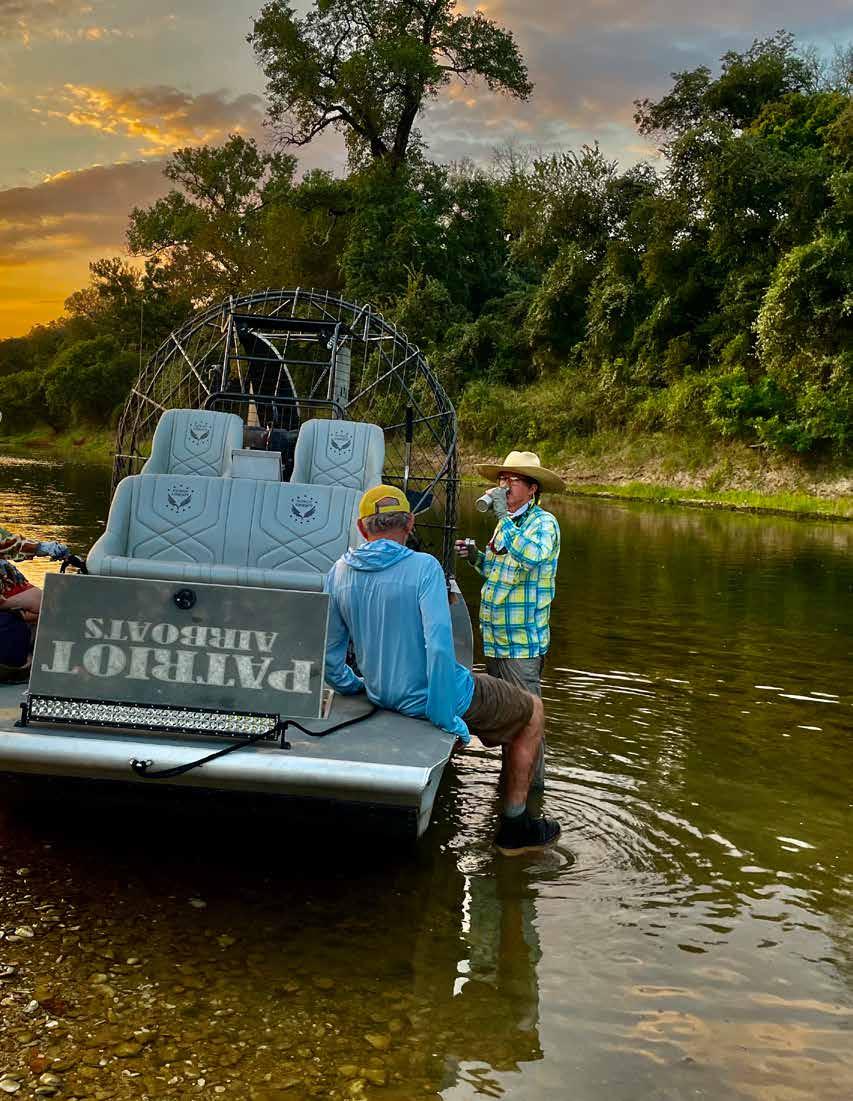

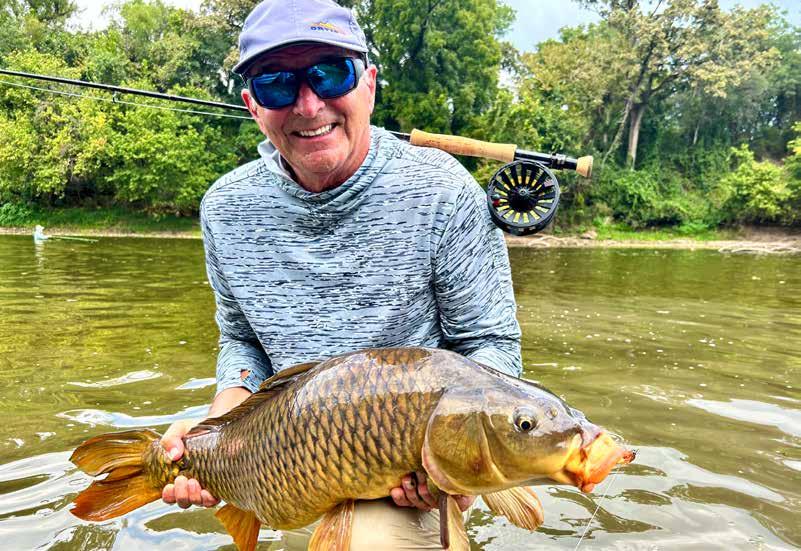


By Keith Mars
As fly anglers, we’ve long cherished the thrill of landing a gator Speckled Seatrout. These silvery gamefish, adorned with their signature spots, have been a staple of our Gulf Coast fisheries for generations. However, recent years have seen significant changes in regulations surrounding this beloved species, particularly in Texas and Louisiana. Between freezes, habitat loss, and fishing pressure our Texas trout have taken a hit. Louisiana hasn’t fared much better, but they’ve been way behind Texas on slot and keeper limits. Well that’s changed in 2023 and 2024 as in Texas we’ve seen a steady tightening of limits the past few years while Louisiana is finally making moves to better manage the fishery.
The Texas Parks and Wildlife Department (TPWD) has recently implemented new regulations for Speckled Seatrout, effective in March 2024, in response to ongoing conservation concerns and updated population assessments.
As of early 2024, TPWD has made the following changes to Speckled Seatrout regulations:
• The daily bag limit has been reduced from 5 to 3 fish per person statewide.
• A new slot limit of 15-20 inches has been implemented across all Texas coastal waters.
• Anglers are now allowed to keep only one fish over 30 inches per day as part of their daily limit.
These new regulations are designed to protect spawning-size fish while still providing quality angling opportunities. Most speckled seatrout over the new slot limit are females and commonly live to be nine or 10 years of age. We long ago

recognized that very large trout were usually female and appropriately called them “sow” trout. A female speck may spawn several times during the season and release hundreds of thousands of eggs. Now you can see why protecting these fish is so critical to sound management and future generations.
Louisiana, traditionally known for its liberal fishing regulations, took steps to protect its Speckled Seatrout population in 2023, marking a substantial shift in the state’s approach to managing this valuable species.
In response to concerning population trends, the Louisiana Wildlife and Fisheries Commission implemented new, more restrictive regulations for Speckled Seatrout in 2023. For the first time since the 1980s, Louisiana has changed speckled seatrout limits:
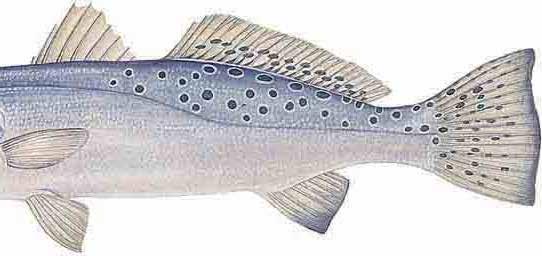
• The daily bag limit was reduced from 25 to 15 fish per person.
• A new slot limit of 13-20 inches.
• Anglers can keep two fish per day over the 20-inch slot limit.
The recent changes in Speckled Seatrout regulations represent a significant shift towards more conservative management of this iconic fish of our gulf coast. It’s also a continued sign of the impact conservation groups like Coastal Conservation Association are having on the science-driven management of coastal fisheries, including the wins last year on closing sensitive oyster fisheries. Now, I know many of us are catch-and-release fisherman, but a couple of fresh trout for the frying pan sure hit the spot. Keep a few, stay in the limits, and let the big ones go to make sure these fish are here for generations to come.
Texas Parks and Wildlife Department: Seatrout Bag & Length Limits
Valid: Sep. 1, 2024 through Aug. 31, 2025
Daily Bag: 3
Min Length: 15 inches
Max Length: 20 inches
Possession Limit: Double the daily bag limit Clarification: During a license year, one spotted seatrout over 28” may be retained when affixed with a properly completed Spotted Seatrout Tag and one spotted seatrout over 28” may be retained when affixed with a properly completed Bonus Spotted Seatrout Tag. Any fish retained under authority of a Spotted Seatrout Tag or a Bonus Spotted Seatrout Tag may be retained in addition to the daily bag and possession limit as stated in this section.
by Bob Maindelle
In summary, SKIFF took lemons and made lemonade this summer season. Abundant rainfall in late April and throughout May caused flooding on the two reservoirs where SKIFF fishing trips are conducted – Lake Belton and Stillhouse Hollow Reservoir. These lakes were both closed for approximately seven weeks right as public school was ending – the time when SKIFF trip requests normally peak.
Both lakes reopened by early July, and since that time, we have been able to conduct six additional trips on top of the thirteen which had been conducted prior to the flooding and closure.
Fishing on Lake Belton has been consistent, with a mixture of panfish and white bass making up the lion’s share of each catch. The number of fish trip recipients have landed has been excellent.
In these six trips conducted since the lakes reopened, the total number of fish caught by the participants was 419. That equates to just over 69 fish per trip on average, or just under 35 fish per child. The average catch per child since SKIFF’s founding in 2009 is just over 27 fish.
The younger kids are, the more variety they require in order to keep them engaged. Fishing may be wildly productive, but, if catching eager fish requires a young child to do the same thing for any length of time, that child will get bored doing it.
For this reason, I always plan to pursue multiple species using a multitude of techniques on any given trip. For most of these post-flooding trips we have been using Pet Spoons behind downriggers to catch white bass, using telescoping bream
poles with bait to catch panfish in shallow cover, and using MAL Mini in-line spinners fished vertically in conjunction with Garmin LiveScope to catch a mixed bag of gamefish, including largemouth bass, smallmouth bass, white bass, and hybrid striped bass.
The six families served thus far this summer include the families of:
(1) Army First Sergeant Matthew Barber and Mrs. Brittani Barber.
(2) Army Specialist Dustin Morris and Mrs. Shayla Morris.
(3) Army Chief Warrant Officer 2 Rolando Saldana.
(4) Army Command Sergeant Major Michael Miller.
(5) Army Major Raymond Klutse and Mrs. Brandy Klutse.
(6) Army Staff Sergeant Randall Pierce and Mrs. Gabbie Pierce.
With all local Fort Cavazos area school districts going back in session this coming week, the request for trips will slow, but we will continue to intentionally give priority to SKIFF requests on Saturday and on any weekday where school districts have days off.
A huge “thank you” to all of our donors, including the Austin Fly Fishers, the McBride Foundation, Austin Subaru and individuals too numerous to list for allowing us to say “YES!” anytime a request comes in.
Bob Maindelle Owner,
Holding the Line Guide Service 254.368.7411 (call or text)
www.HoldingTheLineGuideService.com Bob@HoldingTheLineGuideService.com www.Facebook.com/bobmaindelle
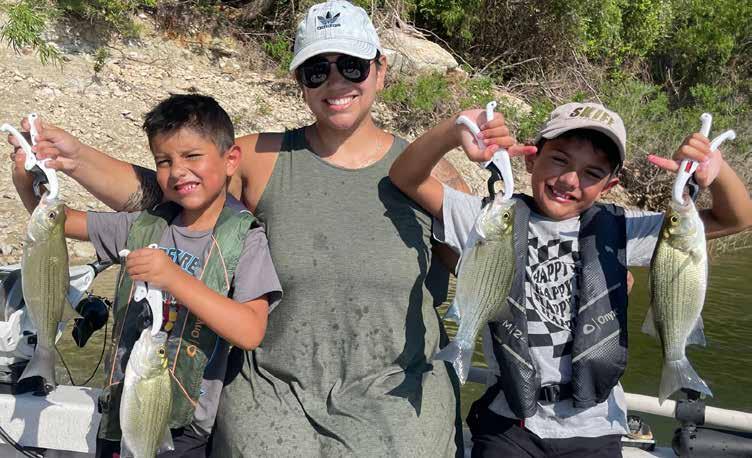
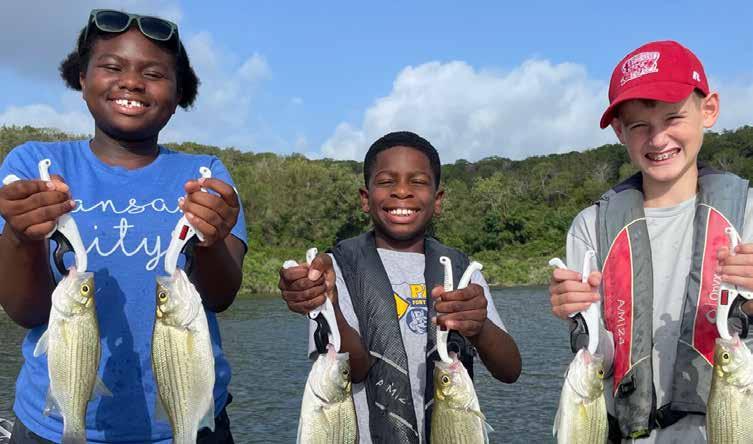

Army Command Sergeant Major Michael Miller who is a geographical bachelor stationed at Fort Cavazos with his family located at Fort Knox, KY. Javon landed 90 fish.
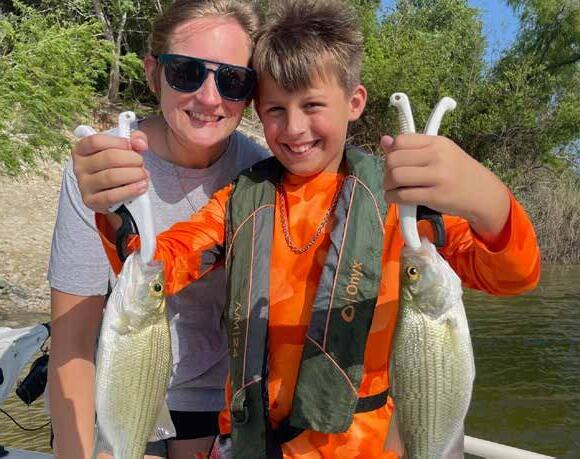
Army Specialist Dustin Morris and Mrs. Shayla Morris while SPC Morris is deployed to Eastern Europe. Christopher and Benny landed 75 fish.



Army Staff Sergeant Randall Pierce and Mrs. Gabbie Pierce while SSG Pierce is at gunnery following a field training exercise, and prior to leaving for a military school. Randall and Robert landed 74 fish.
Army Chief Warrant Officer 2 Rolando Saldana and Mrs. Monica Saldana. Chase and Christian landed 88 fish.
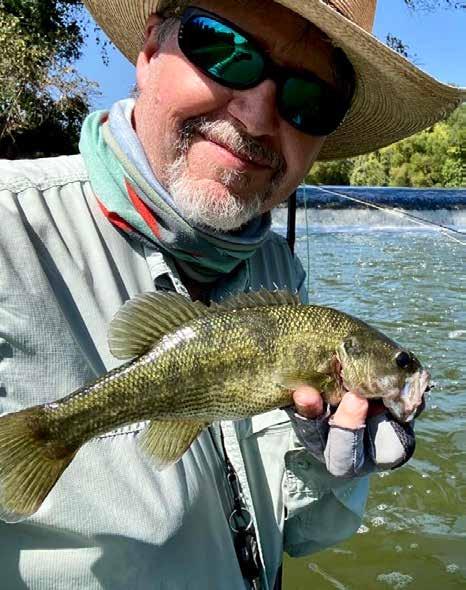
Jim Gray
Jim has been fly fishing and fly tying for over 40 years, the last 25 based in the Central Texas Hill Country. Jim and Jeff Hoelter designed the Llanolope, one of the most popular flies in Central Texas. Jim also developed the Jim’s Damsel and the SB100. texasjimgray@yahoo.com

Will Herring & Jordan
Will and Jordan started Camp: a flyfishing oriented ness on the Brazos Whitney. Brazos River out of the desire to share of the Brazos River (28 lenging to access. brazosriverfishcamp@gmail.com
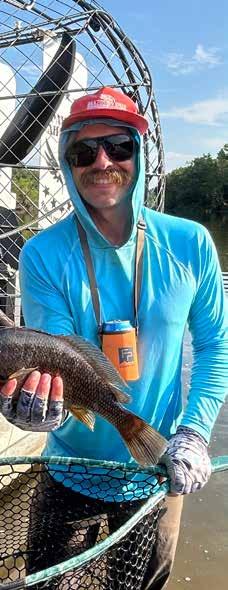
Jordan Marsh started Brazos River Fish oriented outfitting busiRiver, south of Lake River Fish Camp was born share an amazing stretch (28 miles) that is chalbrazosriverfishcamp@gmail.com

Judson Cole, Judson is the head guide and owner of the new Rio Anglers. With 15 years of experience, I’m a passionate fly fishing guide dedicated to sharing my love for the sport and the beauty of the Texas Hill Country with anglers of all skill levels.
https://rioanglers.com/guide-services
by Jim Robinson
Cassio Silva – https://www.cassiosilvaflyfishing.com Central Texas Fly Fishing Guide
Aaron Reed – https://flyfishingaustin.thelocalangler.com/author/aaronreed/ Author Fishing Guide
Austin Orr – https://www.elevateflycasting.com Certified Casting Instructor
Ted Mendrek – https://sportsmansfinest.com Sportsman’s Finest Fly Shop
Chris Johnson – http://livingwatersflyfishing.com/ Living Waters Fly Shop and Central Texas Guide
Capt. Eric Glass – http://www.captainericglass.com/ Fly Fishing South Padre Island
Nick Streit – https://taosflyshop.com/flyguide/main New Mexico and Southern Colorado
Justin Spence – https://bigskyanglers.com Fly Shop and Guide Service West Yellowstone, Montana
Cari Ray – https://fisherofzen.com/shop/ Central Texas and Colorado Fly Fishing Guide and Casting Instructor
Capt. Chris Conant – https://www.mdfishco.com Sportsman’s Finest Fly Shop and Hosted Trips
